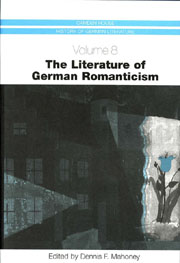Book contents
- Frontmatter
- Contents
- Illustrations
- Acknowledgments
- Abbreviations
- Introduction
- From “Romantick” To “Romantic”: The Genesis of German Romanticism in Late Eighteenth-Century Europe
- Goethe and the Romantic
- Early Romanticism
- From Goethe's Wilhelm Meister to anti-Meister Novels: The Romantic Novel between Tieck's William Lovell and Hoffmann's Kater Murr
- Tales of Wonder and Terror: Short Prose of the German Romantics
- The Romantic Drama: Tieck, Brentano, Arnim, Fouqué, and Eichendorff
- German Romantic Poetry in Theory and Practice: The Schlegel Brothers, Schelling, Tieck, Novalis, Eichendorff, Brentano, and Heine
- The Turn to History and the Volk: Brentano, Arnim, and the Grimm Brothers
- History and Moral Imperatives: The Contradictions of Political Romanticism
- Romanticism and Natural Science
- Gender Studies and Romanticism
- The Romantic Preoccupation with Musical Meaning
- Romanticism and the Visual Arts
- Goethe's Late Verse
- The Reception of German Romanticism in the Twentieth Century
- Works Cited
- Notes on the Contributors
- Index
Goethe and the Romantic
Published online by Cambridge University Press: 05 February 2013
- Frontmatter
- Contents
- Illustrations
- Acknowledgments
- Abbreviations
- Introduction
- From “Romantick” To “Romantic”: The Genesis of German Romanticism in Late Eighteenth-Century Europe
- Goethe and the Romantic
- Early Romanticism
- From Goethe's Wilhelm Meister to anti-Meister Novels: The Romantic Novel between Tieck's William Lovell and Hoffmann's Kater Murr
- Tales of Wonder and Terror: Short Prose of the German Romantics
- The Romantic Drama: Tieck, Brentano, Arnim, Fouqué, and Eichendorff
- German Romantic Poetry in Theory and Practice: The Schlegel Brothers, Schelling, Tieck, Novalis, Eichendorff, Brentano, and Heine
- The Turn to History and the Volk: Brentano, Arnim, and the Grimm Brothers
- History and Moral Imperatives: The Contradictions of Political Romanticism
- Romanticism and Natural Science
- Gender Studies and Romanticism
- The Romantic Preoccupation with Musical Meaning
- Romanticism and the Visual Arts
- Goethe's Late Verse
- The Reception of German Romanticism in the Twentieth Century
- Works Cited
- Notes on the Contributors
- Index
Summary
Anyone attempting to compare or correlate the histories of German and English literature in the period between 1750 and 1850 can quickly become frustrated by the incommensurable categories deployed in the respective camps. Students of German literature who are used to thinking in terms of the succession Aufklärung (Enlightenment), Sturm und Drang (Storm and Stress), Klassik, Romantik, and Vormärz (Literature up to March 1848) encounter an entirely different sequence in English. There one finds categories such as the age of Johnson, the age of Sensibility, Gothic, Romantic, and Victorian. The one term that might seem familiar is Romantic. But even there difficulties immediately arise, not least because the English participants did not use the term Romantic of themselves. Complicating matters more is the fact that many critics schooled in the English tradition disregard their German colleagues' distinctions and consider Goethe to be a Romantic writer.
Dismaying though this may be to Germans who are used to thinking of Goethe and Schiller as the pillars of a period of such stellar achievement that it has earned the accolade German Classicism, the view from a more distant outlook is not without merit. The first significant impact of German literature upon English audiences came from the Storm and Stress works, especially Goethe's Die Leiden des jungen Werthers (The Sorrows of Young Werther, 1774), and Schiller's Die Räuber (The Robbers, 1781).
- Type
- Chapter
- Information
- The Literature of German Romanticism , pp. 35 - 60Publisher: Boydell & BrewerPrint publication year: 2003

